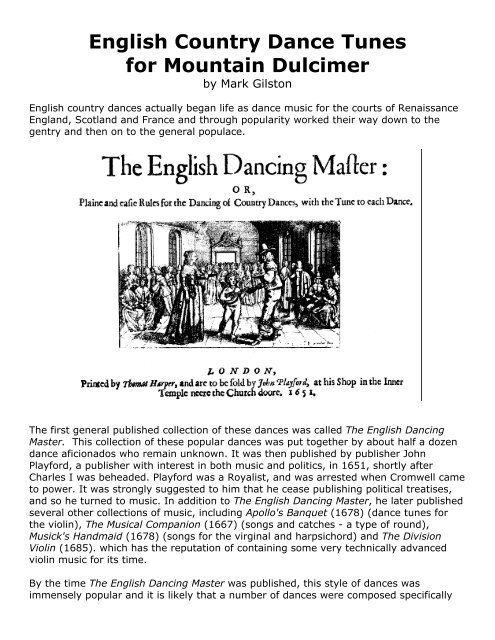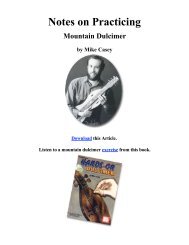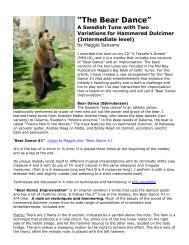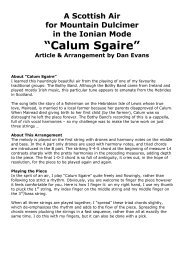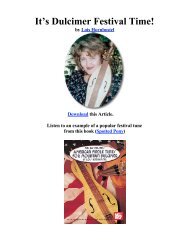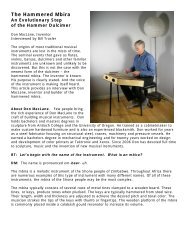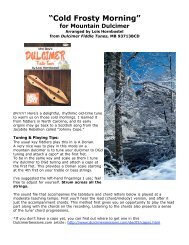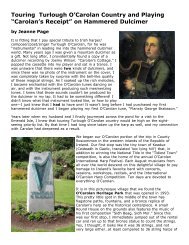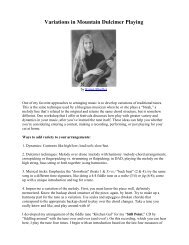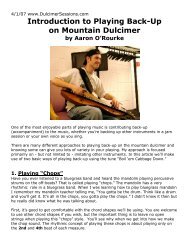Create successful ePaper yourself
Turn your PDF publications into a flip-book with our unique Google optimized e-Paper software.
English Country Dance Tunes<br />
for Mountain Dulcimer<br />
by Mark Gilston<br />
English country dances actually began life as dance music for the courts of Renaissance<br />
England, Scotland and France and through popularity worked their way down to the<br />
gentry and then on to the general populace.<br />
The first general published collection of these dances was called The English Dancing<br />
Master. This collection of these popular dances was put together by about half a dozen<br />
dance aficionados who remain unknown. It was then published by publisher John<br />
Playford, a publisher with interest in both music and politics, in 1651, shortly after<br />
Charles I was beheaded. Playford was a Royalist, and was arrested when Cromwell came<br />
to power. It was strongly suggested to him that he cease publishing political treatises,<br />
and so he turned to music. In addition to The English Dancing Master, he later published<br />
several other collections of music, including Apollo's Banquet (1678) (dance tunes for<br />
the violin), The Musical Companion (1667) (songs and catches - a type of round),<br />
Musick's Handmaid (1678) (songs for the virginal and harpsichord) and The Division<br />
Violin (1685). which has the reputation of containing some very technically advanced<br />
violin music for its time.<br />
By the time The English Dancing Master was published, <strong>this</strong> style of dances was<br />
immensely popular and it is likely that a number of dances were composed specifically
for the book. References to specific English country dances show up in many works of<br />
English fiction throughout the 17 th and 18 th centuries. There have been many<br />
subsequent editions of The English Dancing Master with revisions and enlargements until<br />
the final edition which was published in 1728. John Playford published the first seven<br />
editions, and, after his death in 1686, his son, Henry, published the next five. There<br />
were seventeen editions in all.<br />
Illustration from The Dancing Master: Vol. The First... The 18th Edition<br />
London: Edward Midwinter and John Young, [1728].<br />
Courtesy of the Library of Congress.<br />
The dances in The English Dancing Master represent a delightful cross-section of the<br />
popular music of the late 17 th and 18 th centuries and generally have the flavor so typical<br />
of the late English Renaissance and early Baroque periods. Although they can be quite<br />
chromatic and have a tendency to modulate at least once in their brief appearance,<br />
many of them still lend themselves well to the light touch of the chord-melody style of<br />
mountain dulcimer playing. The dulcimer is well able to capture that lute-like quality<br />
which so enhances these pieces. By plucking close to the bridge and then moving away<br />
from it on the repeats, one can imitate one of the typical sound techniques used in<br />
Elizabethan lute music.<br />
Many of the tunes in Playford are meant as an outline, and the style of the day was to<br />
play them once as written and then to embellish and improvise. My tablature is a<br />
compromise with emphasis given to the tunes as written, but a certain amount of<br />
embellishment is occasionally included, particularly in the simpler tunes. The original<br />
manuscript shows melody only, so chords and countermelodies are left up to the<br />
performer. I have tried to include counterpoint and chordal harmonies which would have<br />
been appropriate to the period while following the rules of voice leading as best as the<br />
dulcimer will allow.
Above is an example of how one of the dances actually appeared in The English Dancing<br />
Master. The melody is given in the popular print notation of the time, with dance<br />
instructions underneath. The instructions are in a sort of shorthand which is explained at<br />
the beginning of the book.<br />
“Woodycock” is the old spelling, coming from a time when spelling was often<br />
inconsistent. “Woodycock” refers to the Middle English “wodecok” (from old English<br />
‘wuducoc’), a common game bird. Today, the bird is known as a woodcock, and the tune<br />
is generally spelled “Woodicock.”<br />
Below is my basic arrangement of the tune, though in performance I embellish it with<br />
several improvised variations in keeping with the style of playing in the 17 th century.<br />
Listen to Mark playing “Woodicock” here:<br />
http://www.markgilston.com/music/Woodicock.m3u<br />
My convention is to write the basic melody of the tune in the music notes and write out<br />
the full tablature below. This enables other musicians to read the music along with the<br />
dulcimer player without being confused by the extraneous notes. It should help guide<br />
the dulcimer player as to which of the notes are critical and which can be left out if<br />
simplification is desired. The chords are those implied by the tablature. Other options<br />
are possible, but they would be likely to clash with the arrangement. For the best effect<br />
when playing the tablature, play only the notes that are specifically indicated. Only<br />
strum across all the strings, when the tab indicates that all the strings are played. Use a<br />
rhythmic strumming pattern and pluck the individual strings when so directed. Strum<br />
away on the main beats and pick up the individual unaccented beats on the return<br />
strokes unless specifically instructed otherwise in the tab.
I have added a minimal amount of ornaments, but those added are appropriate to<br />
proper English styling. The tradition in <strong>this</strong> music is to play the piece simply the first<br />
time through and then to embellish and create variations on subsequent repeats.
About the Author<br />
Photo by Dale Rempert<br />
Mark Gilston has been performing traditional folk music for forty years. His vast<br />
repertoire encompasses songs and instrumentals from North America and most of<br />
Europe, particularly the British Isles, Scandinavia, and the Balkans.<br />
Mark was born and raised in New York City. Both of his parents were steeped in the folk<br />
music revival scene of the 1950's. He grew up listening to 78's and LP's of American,<br />
Russian, Spanish, Caribbean and Israeli folk music. His sister was a professional harpist.<br />
Learning guitar and taking piano lessons starting at age 5, he was constantly immersed<br />
in music.<br />
His interest in Balkan music developed in his early teens when he began folk dancing. A<br />
good friend sent him back a goat-skin bagpipe from Bulgaria and he began to teach<br />
himself how to play the instrument in 1969. In 1970 he moved to Montreal to go to<br />
college and became a regular at the Yellow Door Coffeehouse where he bought his first<br />
own dulcimer. He started playing concertina two years later.<br />
After earning a Bachelor's degree in Folklore, Mark went to graduate school at SUNY<br />
Binghamton and ended up settling there until 1994. In May of 2002, Mark moved to<br />
Austin, Texas and in 2004, Mark won the Oklahoma State Mountain Dulcimer<br />
Championship.
Mark has given concerts for numerous colleges, folk music organizations and clubs and<br />
performed and given workshops at festivals throughout the United States, as well as<br />
England and Canada.<br />
Mark has written two books of English Country Dance tunes for mountain dulcimer, each<br />
which comes with a CD with all the tunes played in a concert style performance. The<br />
books with CDs are available at http://www.markgilston.com/ and the CDs without the<br />
books as well as his other 7 CDs can be purchased at<br />
http://www.cdbaby.com/all/markgilston .<br />
If you enjoyed <strong>this</strong> article and music you might also like the following from Steven K.<br />
Smith entitled “Elizabethan Music for Mountain Dulcimer”:<br />
http://www.dulcimersessions.com/feb04/Elizabethan.html


